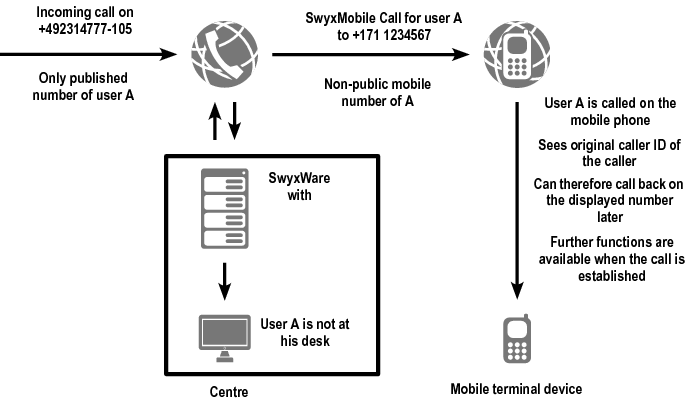SwyxIt! Mobile 2013 Scenario with examples of Incoming and Outgoing Calls
The SwyxMobile scenario is explained and illustrated with examples below.
SwyxIt! Mobile 2013 scenario for incoming calls
An external user C dials the office phone number of user A (+49 231 4777105). The call is directed via the PSTN to the SwyxServer and signaled on the terminal device (e.g. on SwyxIt! or the SwyxPhone) in the office of user A, and also on his mobile phone. This involves a second call from the MobileExtensionManager to the mobile phone. If user A takes the call on the mobile, the two calls are merged.
The number of caller C is shown in the display on user A's mobile phone. This means that user A can call caller C back if necessary. If the call is transferred over the GSM network, the ISDN function "CLIP no Screening" is needed for this. It is not necessary if the call is transferred via SIP. For a call transferred via SIP, user A sees caller C's number in any case.
During the active conversation, user A can use various SwyxWare functions (e.g. hold, swap, forward, etc.) from the SwyxIt! Mobile menu. For details of the available SwyxWare functions, please refer to
chapter Available SwyxWare functions.
Fig. 22-1: Example for Incoming Call.
| As soon as either an incoming or an outgoing call is made with the mobile phone via the MobileExtensionManager, the status of the user (e.g. speaking) is displayed to other SwyxWare subscribers. |
If user A has not installed SwyxIt! Mobile on his mobile phone, he has to press # after pressing the answer button. Acceptance of the call is thus signaled to the MobileExtensionManager, and it knows that the call has not gone to voicemail. It then connects the media streaming of the calls. (
see also chapter Function Codes on the MobileExtensionManager).

